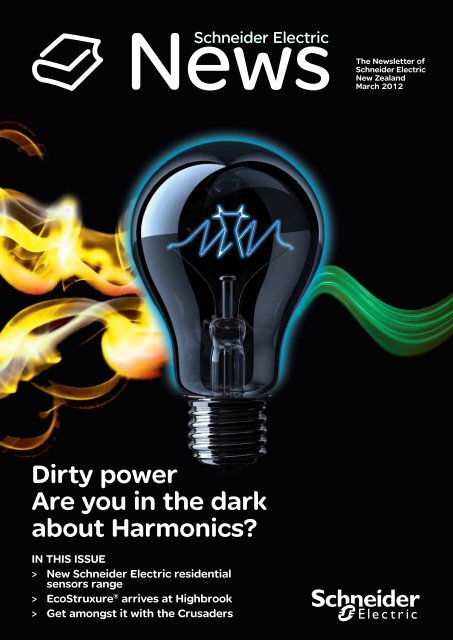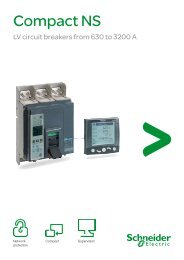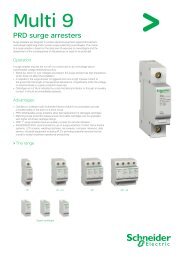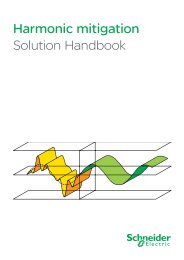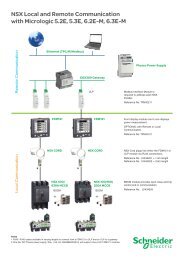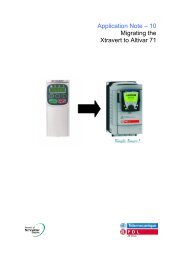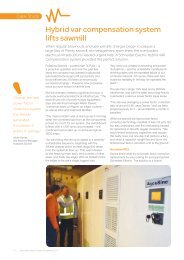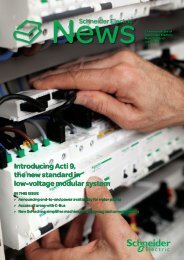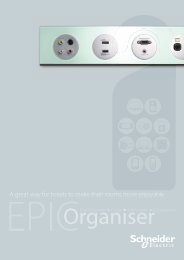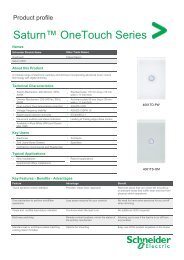Dirty power Are you in the dark about Harmonics? - Schneider Electric
Dirty power Are you in the dark about Harmonics? - Schneider Electric
Dirty power Are you in the dark about Harmonics? - Schneider Electric
Create successful ePaper yourself
Turn your PDF publications into a flip-book with our unique Google optimized e-Paper software.
News<br />
<strong>Schneider</strong> <strong>Electric</strong><br />
The Newsletter of<br />
<strong>Schneider</strong> <strong>Electric</strong><br />
New Zealand<br />
March 2012<br />
<strong>Dirty</strong> <strong>power</strong><br />
<strong>Are</strong> <strong>you</strong> <strong>in</strong> <strong>the</strong> <strong>dark</strong><br />
<strong>about</strong> <strong>Harmonics</strong>?<br />
IN THIS ISSUE<br />
> > New <strong>Schneider</strong> <strong>Electric</strong> residential<br />
sensors range<br />
> > EcoStruxure ® arrives at Highbrook<br />
> > Get amongst it with <strong>the</strong> Crusaders
Cover Story<br />
Effects of<br />
harmonic<br />
distortion:<br />
> > Increased <strong>the</strong>rmal<br />
losses<br />
> > Increased<br />
equipment failures<br />
> > Reduced<br />
productivity<br />
> > Reduced device<br />
lifetime<br />
> > Reduced energy<br />
efficiency<br />
Towards cleaner <strong>power</strong><br />
Emerg<strong>in</strong>g regulations may see large electricity users come under <strong>in</strong>creas<strong>in</strong>g<br />
pressure to <strong>in</strong>stall specialised filter<strong>in</strong>g equipment aimed at improv<strong>in</strong>g <strong>the</strong><br />
quality of electricity <strong>in</strong> New Zealand, says Marc Marchal, a clean <strong>power</strong> specialist<br />
at <strong>Schneider</strong> <strong>Electric</strong>.<br />
As with any o<strong>the</strong>r country, New Zealand’s<br />
electricity network is “contam<strong>in</strong>ated” by many of<br />
<strong>the</strong> devices us<strong>in</strong>g <strong>the</strong> <strong>power</strong>. Such devices, often<br />
called “non-l<strong>in</strong>ear loads”, draw current from <strong>the</strong><br />
ma<strong>in</strong>s with a waveform that conta<strong>in</strong>s frequencies<br />
higher than <strong>the</strong> 50Hz standard. “Increas<strong>in</strong>g levels<br />
of <strong>the</strong>se frequencies actually compromises <strong>the</strong><br />
quality of <strong>the</strong> electricity network”, says Marc,<br />
“contribut<strong>in</strong>g to transmission losses. It also<br />
negatively affects <strong>the</strong> performance of many o<strong>the</strong>r<br />
devices or appliances connected to that network.”<br />
The formal name for <strong>the</strong> pollut<strong>in</strong>g phenomenon<br />
is harmonic distortion, and network operators,<br />
understandably, are concerned <strong>about</strong> it. “It’s<br />
a quirk of electricity and it’s noth<strong>in</strong>g new – it’s<br />
been around s<strong>in</strong>ce electricity was discovered.<br />
The problem is most acute with large users<br />
of electricity – typically <strong>in</strong> <strong>the</strong> <strong>in</strong>dustrial and<br />
agricultural sectors which are operat<strong>in</strong>g significant<br />
non-l<strong>in</strong>ear loads. But it’s also prevalent <strong>in</strong> large<br />
commercial build<strong>in</strong>gs, which have <strong>power</strong>ful<br />
heat<strong>in</strong>g and ventilation systems and extensive<br />
fluorescent light<strong>in</strong>g and computer networks.”<br />
<strong>Electric</strong>ity network operators worldwide tackle <strong>the</strong><br />
problem by <strong>in</strong>sist<strong>in</strong>g that customers <strong>in</strong>stall filter<strong>in</strong>g<br />
technology to elim<strong>in</strong>ate harmonic distortion. Such<br />
filters ensure that <strong>the</strong> electricity be<strong>in</strong>g fed back<br />
<strong>in</strong>to <strong>the</strong> network rema<strong>in</strong>s at 50Hz.<br />
Legislation<br />
As <strong>in</strong> o<strong>the</strong>r countries, says Marc, “New Zealand<br />
has legislation – such as ECP36 – to address<br />
harmonic distortion. But it’s a little dated<br />
and because we have a number of network<br />
operators, a variety of different standards are<br />
be<strong>in</strong>g employed. It’s all become impractical<br />
and difficult to implement and enforce.”<br />
That may all be <strong>about</strong> to change, however,<br />
with <strong>the</strong> <strong>Electric</strong>ity Eng<strong>in</strong>eers Association of<br />
New Zealand (EEA) hav<strong>in</strong>g had a workgroup<br />
look<strong>in</strong>g <strong>in</strong>to <strong>the</strong> harmonic distortion issue for<br />
many months and develop<strong>in</strong>g new guidel<strong>in</strong>es.<br />
It is encourag<strong>in</strong>g its members (<strong>the</strong> Utilities and<br />
network operators) to adopt <strong>the</strong>se new guidel<strong>in</strong>es.<br />
“A national set of regulations will significantly<br />
advance <strong>the</strong> country’s ability to use its energy<br />
more efficiently,” says Marc, “as well as offer<br />
enormous performance benefits to electricity<br />
users.<br />
“Unfortunately <strong>the</strong>re isn't a silver bullet for<br />
mitigat<strong>in</strong>g harmonics. The best results are<br />
obta<strong>in</strong>ed by careful eng<strong>in</strong>eer<strong>in</strong>g ensur<strong>in</strong>g<br />
compliance is achieved, while balanc<strong>in</strong>g <strong>the</strong><br />
cost of <strong>the</strong> <strong>in</strong>itial <strong>in</strong>vestment aga<strong>in</strong>st ongo<strong>in</strong>g<br />
operational expenditure for <strong>the</strong> overall solution.”<br />
HV / MV<br />
Industrial<br />
customers<br />
O<strong>the</strong>r <strong>in</strong>dustrial<br />
customers<br />
PCC<br />
Public MV Network<br />
(IEC 61000-3-6)<br />
MV / LV<br />
Marc Marchal is a<br />
Systems and Architecture<br />
Eng<strong>in</strong>eer at <strong>Schneider</strong><br />
<strong>Electric</strong>. He has worked <strong>in</strong><br />
<strong>the</strong> <strong>in</strong>dustry for 25 years<br />
(locally and overseas) and<br />
is recognized as an expert<br />
<strong>in</strong> AC motor control and<br />
clean <strong>power</strong>.<br />
Residential<br />
IEC 61000-3-2 /-3-12<br />
MV / LV<br />
Commercial &<br />
Light <strong>in</strong>dustries<br />
PCC<br />
IEC 61000-3-12<br />
IEEE 519 - ER G5/4-1<br />
National regulations<br />
Public LV Network<br />
(future IEC 61000-3-14)<br />
Build<strong>in</strong>gs<br />
HVAC<br />
The <strong>in</strong>ternational landscape for network and product harmonic standards is complex.<br />
Lift<br />
IEC 61000-3-12 EN 12015<br />
Private<br />
LV Network<br />
Equipment<br />
Equipment<br />
Mach<strong>in</strong>e 1<br />
Mach<strong>in</strong>e 2<br />
(i.e. IEC 61800-3 as guidance)<br />
<strong>Schneider</strong> <strong>Electric</strong> News March 2012 3
Cover Story<br />
Clean<strong>in</strong>g up electrical pollution<br />
A Christchurch City Council pump station has become a showcase model for<br />
tackl<strong>in</strong>g a rapidly grow<strong>in</strong>g problem <strong>in</strong> New Zealand – harmonic distortion of <strong>the</strong><br />
electricity supply. <strong>Schneider</strong> <strong>Electric</strong>’s harmonic filter<strong>in</strong>g technology is a key part<br />
of <strong>the</strong> solution.<br />
Harmonic<br />
distortion<br />
contributes<br />
to significant<br />
transmission<br />
losses,<br />
compromis<strong>in</strong>g <strong>the</strong><br />
quality of supply<br />
as well as <strong>the</strong><br />
performance and<br />
efficiency of o<strong>the</strong>r<br />
equipment on <strong>the</strong><br />
same network.<br />
Industry experts often refer to harmonic distortion<br />
as “electrical pollution,” and it has multiple<br />
sources. While it isn’t a new phenomenon,<br />
harmonic distortion has become more prevalent<br />
<strong>in</strong> <strong>the</strong> last few years with <strong>the</strong> rapid growth <strong>in</strong> <strong>the</strong><br />
use of variable speed drives (VSD). VSDs offer<br />
users significant performance and energy benefits,<br />
but <strong>the</strong>y are notoriously enthusiastic generators of<br />
harmonic distortion.<br />
Elim<strong>in</strong>at<strong>in</strong>g <strong>the</strong> distortion requires <strong>the</strong> <strong>in</strong>stallation<br />
of a “filter” to ensure that <strong>the</strong> current flow<strong>in</strong>g back<br />
<strong>in</strong>to <strong>the</strong> network rema<strong>in</strong>s at 50Hz. Unfiltered<br />
current presents <strong>in</strong> many different frequencies,<br />
but eng<strong>in</strong>eers say <strong>the</strong> “fifth harmonic” (250Hz) is<br />
<strong>the</strong> worst, with <strong>the</strong> highest transmission losses.<br />
The problem exists throughout <strong>the</strong> country but<br />
has spiked <strong>in</strong> rural parts of <strong>the</strong> South Island<br />
with <strong>the</strong> grow<strong>in</strong>g use of VSDs <strong>in</strong> <strong>the</strong> boom<strong>in</strong>g<br />
agricultural sector, where <strong>the</strong> drives control large<br />
motors connected to irrigation pumps. Network<br />
operators are understandably concerned <strong>about</strong><br />
<strong>the</strong> ever <strong>in</strong>creas<strong>in</strong>g impact of harmonics on <strong>power</strong><br />
quality. Christchurch-based Orion NZ is one<br />
network operator now demand<strong>in</strong>g <strong>the</strong> <strong>in</strong>troduction<br />
of harmonic distortion filter<strong>in</strong>g technology –<br />
particularly with customers draw<strong>in</strong>g loads larger<br />
than 22kW. Many agricultural operations fall <strong>in</strong>to<br />
that bracket – as do many of <strong>the</strong> Christchurch City<br />
Council’s 370 pump stations.<br />
Sockburn Pump Station<br />
Sockburn is one of <strong>the</strong> Council’s oldest and largest<br />
pump stations and it’s just been upgraded as part<br />
of an overall asset ma<strong>in</strong>tenance programme.<br />
Christchurch’s Powell Fenwick Consultants Ltd<br />
designed <strong>the</strong> new electrical system. The new<br />
technology – <strong>in</strong>clud<strong>in</strong>g a <strong>Schneider</strong> <strong>Electric</strong><br />
Accus<strong>in</strong>e harmonic filter – allowed extensive<br />
rationalisation. Two switchboards and two<br />
transformers have been replaced with a s<strong>in</strong>gle<br />
switchboard and a s<strong>in</strong>gle 750 KVA transformer.<br />
The upgrade also saw <strong>the</strong> <strong>in</strong>troduction of highefficiency<br />
250kW motors for two of <strong>the</strong> ma<strong>in</strong><br />
pumps, with two of <strong>Schneider</strong> <strong>Electric</strong>’s 250kW<br />
Altivar 61 VSDs to control <strong>the</strong>m. Two o<strong>the</strong>r, smaller<br />
pumps are each controlled by 37kW Altivar drives.<br />
An older, direct current motor (with a 164kW thirdparty<br />
DC drive) was reta<strong>in</strong>ed for <strong>the</strong> third ma<strong>in</strong><br />
pump.<br />
Standard drives, says Powell Fenwick eng<strong>in</strong>eer,<br />
Tim Hughes, “can generate harmonic distortion<br />
levels higher than 30% – and to meet Orion’s<br />
stipulated Total Harmonic Distortion threshold<br />
(THDi) of 9.2%, we opted to <strong>in</strong>stall a 300A<br />
Accus<strong>in</strong>e Active filter.”<br />
He goes on to say, “A key advantage of Accus<strong>in</strong>e’s<br />
Active design is its ability to filter all <strong>the</strong> harmonic<br />
loads <strong>in</strong> <strong>the</strong> plant – <strong>in</strong> this case <strong>the</strong> AC as well as<br />
<strong>the</strong> DC drives – collectively, by <strong>in</strong>stall<strong>in</strong>g it at <strong>the</strong><br />
switchboard. Alternative technologies often require<br />
a filter for each <strong>in</strong>dividual drive.<br />
“Fur<strong>the</strong>rmore, <strong>the</strong> Accus<strong>in</strong>e has a built-<strong>in</strong> <strong>power</strong><br />
factor correction capability, allow<strong>in</strong>g us to remove<br />
<strong>the</strong> <strong>power</strong> factor correction on <strong>the</strong> old DC drive, with<br />
<strong>the</strong> filter keep<strong>in</strong>g <strong>the</strong> <strong>power</strong> factor up above 0.95.”<br />
<strong>Schneider</strong> <strong>Electric</strong>, he says, offers an excellent<br />
turnkey solution for <strong>the</strong> <strong>in</strong>stallation of <strong>the</strong> filter<strong>in</strong>g<br />
The Accus<strong>in</strong>e active filter has been <strong>in</strong>stalled at <strong>the</strong> switchboard, provid<strong>in</strong>g<br />
harmonic mitigation for <strong>the</strong> entire plant <strong>in</strong>clud<strong>in</strong>g two 250kW and two 37kW<br />
Altivar 61 VSDs, and a 164kW DC drive.<br />
Mark Johnson, Controls and SCADA eng<strong>in</strong>eer<strong>in</strong>g for Christchurch<br />
City Council monitors <strong>the</strong> Accus<strong>in</strong>e filter performance from <strong>the</strong><br />
built-<strong>in</strong> touch screen HMI.<br />
4 <strong>Schneider</strong> <strong>Electric</strong> News March 2012
Cover Story<br />
How do Accus<strong>in</strong>e Active harmonic filters work?<br />
Accus<strong>in</strong>e Active Harmonic filters cont<strong>in</strong>uously monitor <strong>the</strong> harmonic current spectrum on <strong>the</strong><br />
electrical network. By dynamically <strong>in</strong>ject<strong>in</strong>g current at opposite phase to <strong>the</strong> harmonic frequencies,<br />
<strong>the</strong> filter leaves a near perfect 50Hz s<strong>in</strong>e wave at <strong>the</strong> supply transformer.<br />
Harmonic<br />
generators<br />
Active Filter<br />
Result<br />
MV<br />
A knowledge of<br />
Accus<strong>in</strong>e’s active<br />
design is its ability<br />
to filter all <strong>the</strong><br />
harmonic loads.<br />
2<br />
1,5<br />
0,5 1<br />
0<br />
-0,5<br />
-1<br />
-1,5<br />
-2<br />
+ =<br />
-2<br />
2<br />
2<br />
1,5<br />
0,5 1<br />
1,5<br />
0,5 1<br />
0<br />
0<br />
-0,5 -0,5<br />
-1<br />
-1<br />
-1,5<br />
-1,5<br />
-2<br />
<strong>Harmonics</strong><br />
2<br />
1,5<br />
0,5 1<br />
0<br />
-0,5<br />
-1<br />
-1,5<br />
-2<br />
0<br />
2<br />
Harmonic<br />
generators<br />
M<br />
1,5<br />
0,5 1<br />
-0,5<br />
-1<br />
-1,5<br />
-2<br />
2<br />
1,5<br />
0,5 1<br />
0<br />
-0,5<br />
-1<br />
-1,5<br />
-2<br />
= =<br />
Active<br />
Filter<br />
technology. “We provide <strong>the</strong> parameters and<br />
specifications for <strong>the</strong> drives, and <strong>the</strong>ir eng<strong>in</strong>eers<br />
identify <strong>the</strong> appropriate filter, <strong>in</strong>stall it and<br />
commission it.”<br />
Some 20 pump stations have been upgraded<br />
so far – and many more are earmarked <strong>in</strong> <strong>the</strong><br />
Christchurch City Council’s asset ma<strong>in</strong>tenance<br />
programme. Mark Johnson, its Controls & SCADA<br />
Systems eng<strong>in</strong>eer, says <strong>the</strong> organisation has<br />
chosen to standardise on Altivar drives.<br />
“We particularly like <strong>the</strong> drives’ programmable<br />
pump controller cards. They give operators a far<br />
higher degree of control over <strong>the</strong> pumps – we can<br />
f<strong>in</strong>e-tune <strong>the</strong> duty-cycles more precisely, result<strong>in</strong>g<br />
<strong>in</strong> greater energy efficiency.”<br />
Filter<strong>in</strong>g technology, he po<strong>in</strong>ts out, can also<br />
provide advantages for major electricity users<br />
sett<strong>in</strong>g up new facilities, “If <strong>you</strong>r new plant has a<br />
1MW load, <strong>you</strong>’d th<strong>in</strong>k a 1MVA transformer would<br />
do <strong>the</strong> trick. However, to account for <strong>the</strong> additional<br />
burden and losses caused by harmonic distortion,<br />
electrical design eng<strong>in</strong>eers often over-size <strong>the</strong><br />
expensive supply transformer and electrical<br />
network <strong>in</strong>frastructure. With filter<strong>in</strong>g technology,<br />
<strong>the</strong> bigger transformer might not be required.”<br />
Harmonic mitigation<br />
Solution Handbook<br />
O<strong>the</strong>r distortion sources<br />
Stephen Hirsch, senior eng<strong>in</strong>eer at Orion says<br />
that while VSDs generate high levels of harmonic<br />
distortion, <strong>the</strong>y are not <strong>the</strong> only source of <strong>the</strong><br />
problem. “Major office blocks – which typically<br />
have extensive heat<strong>in</strong>g and ventilation systems,<br />
fluorescent light<strong>in</strong>g <strong>in</strong>frastructures and computer<br />
networks – are equally problematic.”<br />
Such build<strong>in</strong>gs, he says, should also be fitted<br />
with filter<strong>in</strong>g technology – ideally at <strong>the</strong> ma<strong>in</strong><br />
switchboard – and it will be up to country’s<br />
<strong>in</strong>dividual network operators to stipulate and<br />
enforce its <strong>in</strong>troduction.<br />
“Harmonic filter<strong>in</strong>g technology is obviously an<br />
additional cost for users, but it’s important to<br />
understand that left unchecked, <strong>the</strong> distortion<br />
problem will only get worse and ultimately<br />
compromise <strong>the</strong> quality of <strong>the</strong> electricity supply,<br />
network performance and its reliability.”<br />
Do <strong>you</strong> want to know more?<br />
Download our Harmonic<br />
Solution Brochure today!<br />
Visit SEReply.com and enter<br />
<strong>the</strong> keycode 44365Y<br />
<strong>Schneider</strong> <strong>Electric</strong> News March 2012 5


